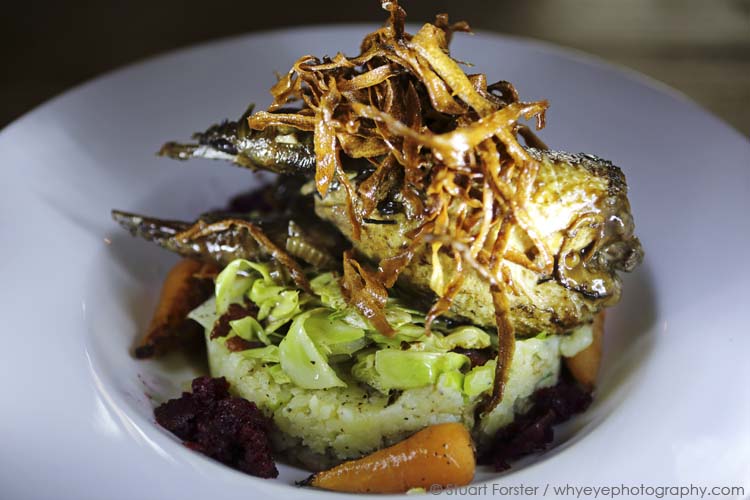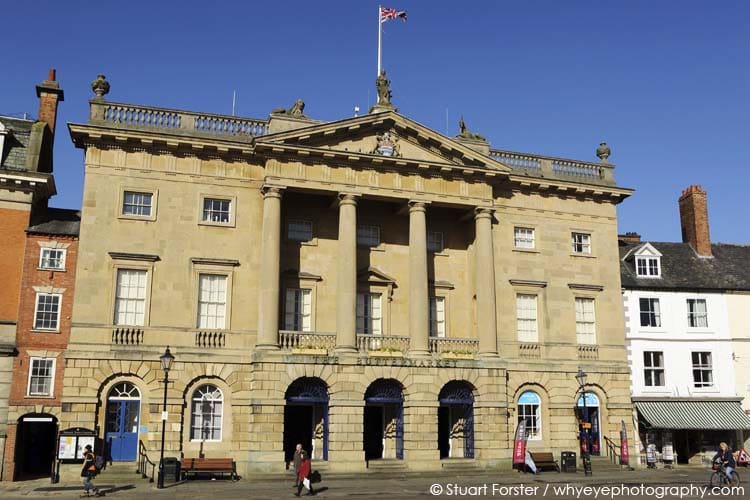Travelling in England by rail, Stuart Forster heads to Nottinghamshire and explores things to do and see in Newark-upon-Trent.
Newark-upon-Trent lies on the United Kingdom’s East Coast Main Line, meaning it’s ideally located for visits by rail. Yet for years it’s also proven a surprisingly easy place for me to zip through without stepping down from the train.
A discounted rail fare offer proves the tipping point for change, encouraging me to take a day trip to Newark, a history-rich town whose heart is a vast, cobbled Market Square. The medieval spire of the Church of St Mary Magdalene peeks above the pastel-fronted buildings abutting the square. The church’s interiors were restored during Victorian times by Sir George Gilbert Scott, the prolific Gothic revivalist architect who designed the Midland Grand Hotel (today the chic St Pancras Renaissance London Hotel).
A photogenic town centre
The most striking facade of the photogenic square is the town hall, an elegant, honey-coloured Georgian building, which I enter to view the restored assembly rooms and to take a look at the civic museum and art gallery. Town charters, mayoral robes plus roughly pressed, diamond-shaped coins known as siege pieces, dating from the Civil War in the 1640s, count among the exhibits.
Newark was a Royalist stronghold during the Civil War and was besieged three times between 1642 and 1646. Newark Castle, whose shell overlooks the River Trent, was torn apart by Parliamentarian troops in 1646.
I wander past a number of timber-framed buildings, including the Governor’s House, which may well be the most eye-catching of all the many Greggs cafés and snack shops in the country. I also spot a handful of antique shops as I mooch around the compact town centre.
The National Civil War Centre
All told, Newark makes a positive impression and I mention this to Michael Constantine, manager of the National Civil War Centre, when we meet at the attraction, which opened on 3 May 2015. He’s heard numerous similar comments and nods. “People here often say ‘Newark’s the best town you’ve never visited’,” he jokes.
The family-friendly centre hosts artefacts and exhibits relating to the build-up to the Civil War, look at how the war affected Newark and the country as a whole and also examines the legacy of the conflict. It has interactive exhibitions plus films bringing to life the stories of individuals involved in the siege of Newark.
Michael explains how an augmented reality Civil War walking trail has been developed. Visitors to Newark can use smartphones and tablets to trigger film clips and games at various points around the town.
The Queen’s Sconce earthworks
On the edge of Newark, in the Sconce and Devon Park, I visit earthworks constructed by Royalist defenders nearly 400 years ago. The Queen’s Sconce is one of the best-preserved examples of 17th-century earthworks in Europe. Defenders stayed ‘ensconced’ as part of efforts to stay safe from cannon and musket fire.
Sitting on a park bench overlooking the sconce, enjoying the warmth of spring sunshine, I can’t help wondering why it’s taken me so long to finally travel to Newark.
Ideas and recommendations
Time for lunch
I paused for a hand-pulled pint and a pot roasted partridge in The Prince Rupert (46 Stodman Street; tel. +44 (0)1636 918121), a pub whose history dates to ‘c.1452’ according to the sign outside. The pub underwent major renovations before re-opening in 2010. It has Olde Worlde-style rooms with oak beams plus a bright conservatory area.
The food served here goes way beyond simple pub grub, though dishes such as fish and chips and burgers are available. My partridge was slow cooked in red wine with smoked bacon and redcurrants and served with savoy cabbage, mashed potato and parsnip crisps and just what I want from a gastropub. The availability of free bottled tap water on tables is a welcome sight after spending a morning walking.
If you enjoy pizza then you may be drawn by the ‘pizza and a pint’ specials or be tempted to design your own from the list of toppings available.

Take something home
Wandering through Newark means you’ll be able to browse the windows of numerous independent shops. The Buttermarket, which was converted to an indoor shopping centre in 1990, is home to several of them.
I picked up a couple of interesting, European craft beers at The Real Ale Store (12–14 Kirk Gate), which stocks bottles produced by international and British breweries.
G.H. Porter Provisions (1-3 Bridge Street) is a fine example of a long-established delicatessen whose displays and shop window continue to look attractive. Porter’s has been in business since 1890 and is best known for smoking meats and roasting coffees.
Quirky but interesting
King John died at Newark Castle on 19 October 1216, a little more than a year after putting his seal to the Magna Carta. John was in conflict with feudal lords, fighting what became known as the First Barons’ War. It was to be John’s last.
Rumours persist that he was poisoned by a monk at Swineshead Abbey, where he stayed after losing his baggage train. It’s now thought John contracted dysentery and that his condition deteriorated over the following days. He was too ill to travel on from Newark and passed away in the castle overlooking the River Trent. His body was moved and buried in Worcester Cathedral.
Time for a coffee
Newark hosts a good number of cafés, including a Starbucks on the marketplace. The Charles I Coffee House (37-39 Kirkgate) is inside the timber-framed building.
I enjoyed a coffee and a slice of carrot cake in Stray’s (16-20 Middlegate; tel. +44 (0)1636 700 597), which doubles as a jazz and tapas venue on Friday evenings. The personable owner, Mat Short, is passionate about jazz and hosts open sessions on the second Sunday of each month.
Frameless, black and white photos of jazz musicians are displayed on the brickwork walls of the split-level café, which backs onto the independent bookshop opened by Short in 2003.
It’s beer o’clock
If you enjoy real ale head to the Just Beer Micropub (32A Castlegate), tucked away off the main road in the Swan and Salmon Yard. This narrow but atmospheric pub has tapped more than 3,000 casks and served more than 2,600 ales since opening in August 2010. You’ll find a dartboard to play with, as well as a beer engine with moving parts. Beers are served from behind a tiny brick-built bar just wide enough for three people to stand abreast.
Getting to Newark-upon-Trent
Newark Northgate is 1 hour 13 minutes north of London Kings Cross railway station, 1 hour 47 minutes south of Newcastle-upon-Tyne and around 3.5 hours from Edinburgh. Newark Northgate station is located just under a mile from the town centre.
When to Go
The National Civil War Centre (14 Appletongate) opened in Newark on 3 May. Historic re-enactment groups were in town over the bank holiday weekend (3-6 May 2015), recreating Civil War fighting between Royalist and Parliamentarian armies.
Where to stay in Newark
Kelham House (Main Street, Kelham; tel. +44 (0)1636 705266) is a country manor located a couple of miles from Newark. This Edwardian house dates from 1903 and provides luxury accommodation in 12 guestrooms. Over recent years Kelham House has been developed into a conference and wedding venue. The hotel’s Kitchen Garden Restaurant serves British and European cuisine.
If you’d prefer to stay in town then the Grange Hotel (73 London Road; tel. +44 (0)1636 703399) may be more your style. The hotel has 19 en suite bedrooms, some with four poster beds, a restaurant and a bar. The well-tended Victorian garden has helped the hotel scoop awards in East Midlands in Bloom competitions.
Further information
See the Visit Newark and Visit Nottinghamshire websites to learn more about the city and surrounding region.
The Visit England website also has information on the region.
If you’ve read this post on things to do and see in Newark-upon-Trent and would like to recommend something that hasn’t been mentioned, please leave a comment below.
Photos illustrating this post are by travel and food specialist Why Eye Photography.
If you enjoyed this post why not sign up for the free Go Eat Do newsletter? It’s a hassle-free way of getting links to posts on a monthly basis.
‘Like’ the Go Eat Do Facebook page to see more photos and content.



